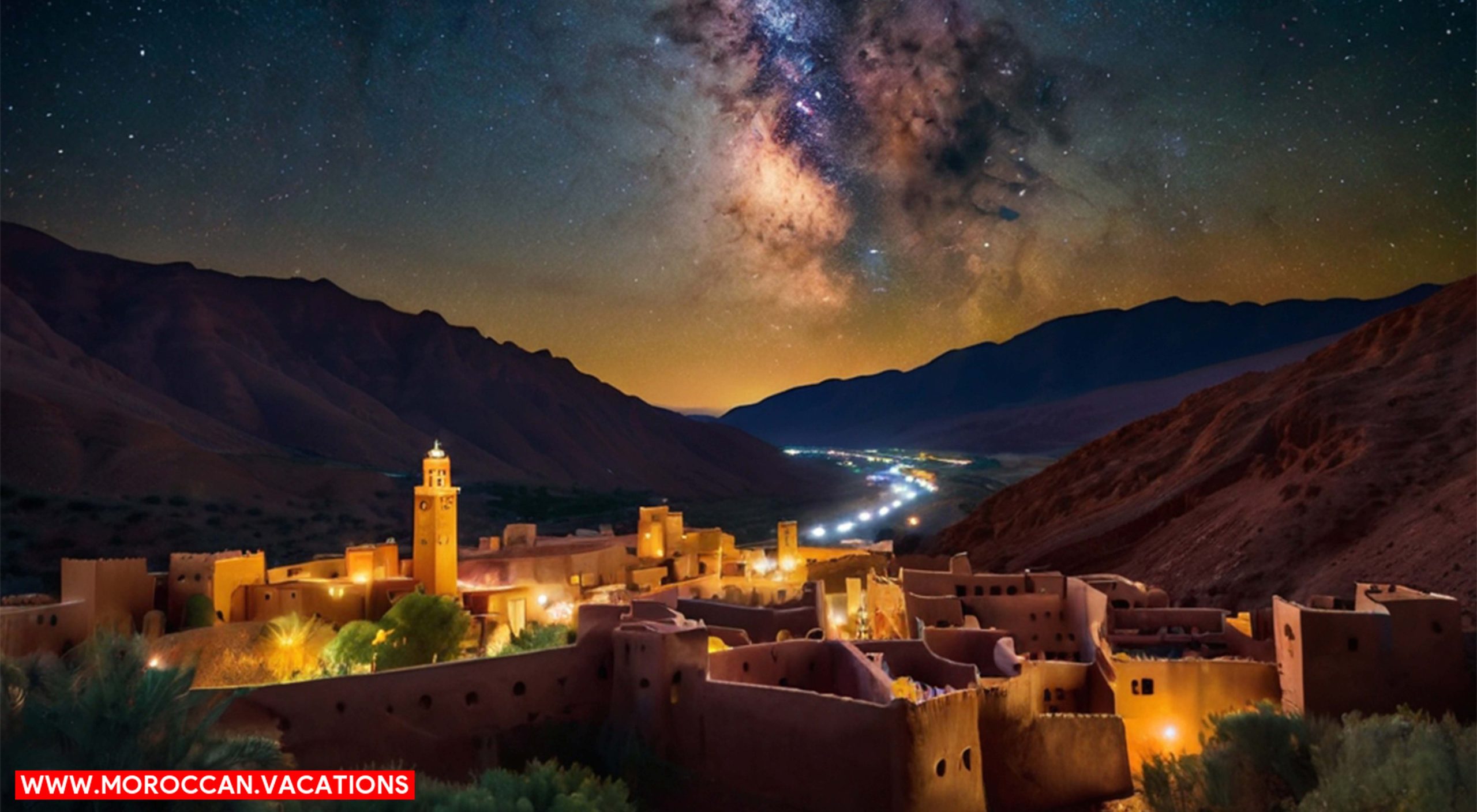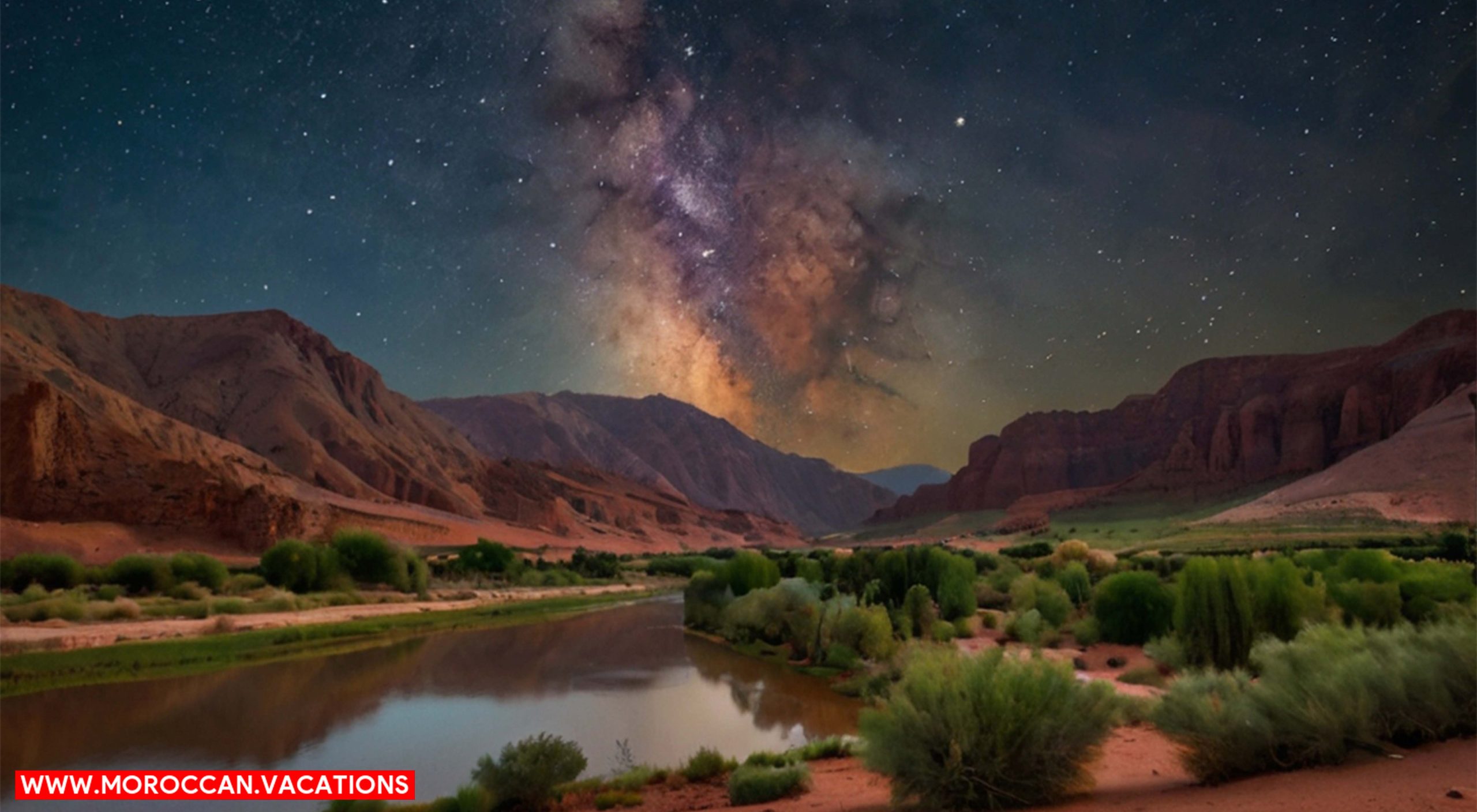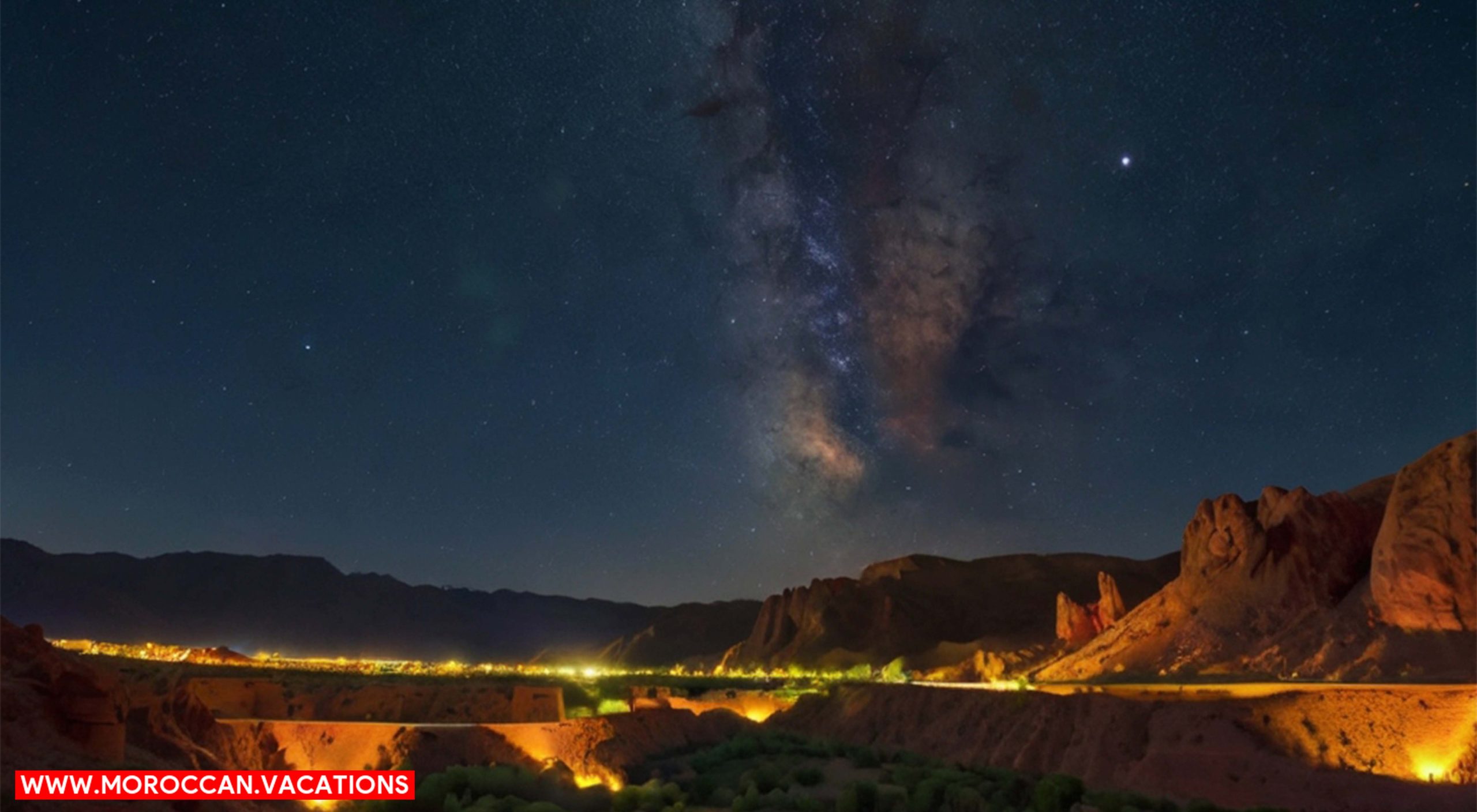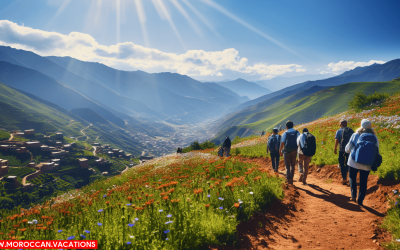Discovering Dades Valley’s Night Sky


Ever gazed up at the night sky and felt dwarfed by its vastness? Welcome to Dades Valley, your gateway to the cosmos. Here, you’ll traverse the celestial realm, identifying constellations and spotting shooting stars. You’re not just an observer; you’re part of this cosmic dance. So, pack your telescope and let’s unravel the universe’s mysteries under the ethereal glow of ‘Starry Nights’. This isn’t just star-gazing, it’s an awakening. Ready to explore the infinite?
In your journey through Dades Valley, you’ll encounter countless opportunities to explore the vast, star-studded night sky. Far from the city’s glare, you’ll feel the freedom to breathe in the cool, clear Moroccan night, your eyes drawn upwards to the celestial wonders twinkling above.
The Dades Valley star-gazing experience is like no other. As darkness cloaks the valley, the night sky in Morocco reveals its cosmic splendor. With the Milky Way stretched out overhead, you can trace the constellations, spot distant galaxies, and maybe even catch a shooting star.
Keep an eye out for Orion, the hunter, his belt a distinctive line of three stars. The North Star, Polaris, a beacon guiding explorers for centuries, is also visible. And, if you’re lucky, you might glimpse the streak of a meteor, a fleeting reminder of the universe’s endless mysteries.
Essential Star-Gazing Equipment
Before diving into your star-gazing adventure, you’ll need to equip yourself with some essential tools to enhance your celestial discovery. Imagine this: you’re nestled in the heart of Dades Valley, surrounded by the stillness of the night. The sky is a vast canvas of starry nights, offering prime opportunities for stargazing. But how can you best explore this cosmic gallery?
Firstly, a good pair of binoculars is indispensable. They’re portable, versatile, and can offer a surprisingly detailed view of the moon, the planets, and deep-sky objects. A star chart or a stargazing app on your smartphone can guide you in identifying constellations, star clusters, and nebulae. A red flashlight will not only help you read your star chart, but also preserve your night vision.
Next, you’ll need a comfortable reclining chair and possibly a warm blanket, depending on the season. Remember, stargazing is not a sprint; it’s a marathon. The longer you observe, the more you’ll see. Patience and comfort are key.
Best Times for Star Observations


To truly appreciate Dades Valley’s celestial spectacle, it’s crucial to understand when you’ll find the best viewing conditions. Let’s start by examining the peak viewing seasons, where certain times of the year offer a more vibrant and diverse astronomical display. Next, we’ll discuss how moon phases and weather conditions can dramatically influence your star-gazing experience.
Peak Viewing Seasons
During certain times of the year, you’ll find the star-gazing in Dades Valley is simply unparalleled. Imagine yourself nestled in the heart of this vast wilderness, where the heavens stretch out above you in an infinite canvas. From late autumn to early spring, the sky is especially clear, offering an unobstructed view of the cosmos. You’ll witness the dance of constellations, planets, and distant galaxies, their ancient light reaching your eyes after travelling across immeasurable distances. The chill of winter enhances the visibility, making the stars appear brighter against the dark sky. So, pack your telescope and warmest clothes, embrace the freedom of the open sky and lose yourself in the celestial symphony. There’s no better place to marvel at the mysteries of the universe than Dades Valley.
Moon Phases Impact
In addition to the seasons, the phases of the moon also play a critical role in your star-gazing experience in Dades Valley. When the moon is new or in a thin crescent phase, it’s the best time to observe the stars. The lesser the moonlight, the more stars you’ll see twinkling in the night sky.
But beware of the full moon phase. Its bright, glowing presence can easily outshine faint stars, making it harder to spot constellations. So, if you’re chasing shooting stars or distant galaxies, plan your adventure around the moon’s cycle.
Weather Conditions Influence
Just as the moon’s phase can alter your view, so too can the weather significantly influence your star-gazing opportunities in Dades Valley. Clear, dry nights with low humidity are your best bet for unobstructed views of the cosmos. Conversely, high humidity, clouds, or light pollution can diminish the quality of your observations.
Consider this simple table to understand how weather conditions impact star visibility:
| Weather Condition | Star Visibility |
|---|---|
| Clear, Dry Night | Excellent |
| High Humidity | Poor |
| Cloudy | Very Poor |
Timing is also crucial. After sunset and before sunrise, known as astronomical twilight, are the prime times. Remember, with patience and the right conditions, you’ll be rewarded with a breathtaking spectacle.
Unveiling Constellations Above Dades
While you’re gazing up at the night sky in Dades Valley, you’ll notice a myriad of constellations that’ll captivate your imagination. Each constellation has its own story, its own rhythm, and it’s your freedom to uncover them.
Here are five constellations you can’t miss:
- Orion: Also known as ‘The Hunter’, it’s one of the most recognizable constellations. Look for three bright stars in a line, Orion’s Belt.
- Cassiopeia: This distinct ‘W’ shaped constellation represents a queen from Greek mythology. It’s an easy find because of its unique shape.
- Ursa Major: You’ll know it as the Great Bear. It’s home to the Big Dipper, an asterism you’ll spot easily.
- Lyra: You’ll identify this small constellation by its brightest star, Vega. Lyra represents the lyre, a musical instrument.
- Scorpius: Resembling a scorpion, it’s one of the easiest constellations to identify in the southern hemisphere.
Meteor Showers: Spectacles of the Night
Imagine the thrill of experiencing a meteor shower in Dades Valley, where the night sky’s canvas unfurls in its full splendor. You’ll learn the optimal times to witness these spectacular events and how best to view them. It’s not just about seeing a shooting star; it’s about understanding the science behind these awe-inspiring spectacles.
Meteor Shower Schedule
Catching a glimpse of meteor showers in Dades Valley’s sky isn’t just enchanting, it’s a spectacle you’ll remember for a lifetime. To ensure you don’t miss these cosmic ballets, here’s a handy schedule:
- The Lyrids, arriving in mid-April, are a spring gift.
- The Perseids, peaking in mid-August, are a summer highlight.
- The Orionids, gracing us in late October, bring autumn magic.
- The Leonids, lighting up mid-November, are a late fall treat.
- The Geminids, dazzling in mid-December, offer winter wonder.
Each shower brings its unique tempo and intensity, painting the sky with fleeting trails of light. So, grab a blanket, escape the city lights, and surrender to the freedom of Dades Valley’s starry spectacle.
Viewing Tips
So, how can you best experience these celestial spectacles in Dades Valley’s night sky? First, you need to plan your viewing. Meteor showers are predictable, but you’ll need clear, dark skies. The best time is after midnight, when the sky is darkest.
Here are some viewing tips:
| Tip | Why | How |
|---|---|---|
| Avoid Light Pollution | It dims the meteors | Choose a dark spot, away from city lights |
| Allow Your Eyes to Adapt | It enhances your night vision | Spend at least 20 minutes in the dark before looking up |
| Be Patient | Meteor showers can be sporadic | Don’t give up too quickly, enjoy the peace of the night |
Moon Phases and Their Impact
You’ll notice four distinct moon phases during your star-gazing experience in Dades Valley, each impacting the night’s visibility in unique ways. The moon’s cycle, from waxing to waning, is a dance of light and shadow that has its own rhythm and allure.
As the moon journeys through its phases, consider the following:
- New Moon: The moon is almost invisible. You’re in for a treat with the Milky Way’s dazzling display.
- First Quarter: A half-lit moon shares the sky with a brilliant array of stars.
- Full Moon: Bathes the landscape in soft light, but fewer stars are visible.
- Last Quarter: The other half-lit moon phase. Get up early to enjoy a morning star-gazing session.
- Waning Moon: Faint stars reappear as the moonlight dims, signaling the start of another cycle.
Each phase holds a unique charm and offers different viewing conditions. No two nights are the same under Dades Valley’s star-strewn sky. So, pack your telescope, shake off the shackles of routine, and let the moon guide your celestial exploration. Freedom isn’t just about roaming the earth; it’s about reaching for the stars.
Night Sky Photography Tips
To capture the breathtaking beauty of Dades Valley’s night sky, you’ll need some essential photography tips. First off, invest in a sturdy tripod. The stability it provides is crucial when shooting long exposures of the stars. Next, you’ll need a camera with manual mode. This allows you to adjust settings like aperture, shutter speed, and ISO – all vital for capturing the night sky in all its glory.
Switch off your autofocus. To get the stars as sharp as possible, manually focus on a bright star or a distant light. Experiment with your camera’s ISO settings. Higher ISOs allow your camera to capture more light, but too high can cause graininess. Find that sweet spot for your specific camera.
Use the rule of thirds for composition. Place the horizon on the bottom or top third of your frame. This gives the stars more room to shine. Lastly, patience is key. Allow yourself the freedom to experiment and make mistakes. After all, it’s through trial and error that you’ll get that perfect shot of Dades Valley’s star-studded sky.
The Significance of Dark Sky Areas
Once you’ve mastered the art of night sky photography, understanding the significance of dark sky areas can elevate your star-gazing experience in Dades Valley to a whole new level. Dark sky areas are regions where light pollution is minimal, allowing for an unobstructed view of the cosmos. These areas are critical for both astronomy and the preservation of nocturnal wildlife.
Now, let’s delve into why these zones are significant:
- Astrophysical Importance: They offer an undisturbed view of our universe, enabling you to capture celestial bodies with clarity.
- Ecological Impact: They help preserve the natural behavior of nocturnal wildlife, which can be disrupted by artificial light.
- Energy Conservation: They encourage reduced use of artificial lighting, promoting energy efficiency.
- Cultural Heritage: They allow us to experience the night sky as our ancestors did, preserving an important part of human history.
- Health Benefits: They remind us of the importance of darkness for human health, particularly for sleep rhythms.
Celestial Events in Dades Valley


As you navigate the darkness of Dades Valley, you’ll discover a calendar rich with celestial events that further enhance your star-gazing experience. Each season offers a different cosmic show. In the crisp winter sky, Geminid and Quadrantid meteor showers streak across the sky, painting arcs of light against the backdrop of distant stars and galaxies.
In spring, as the earth tilts on its axis, Lyrids and Eta Aquarids grace the atmosphere, their trails glowing with an ethereal beauty. Summer nights are filled with the brilliance of the Perseids, a meteor shower known for its spectacular fireballs. As autumn descends, you’ll witness the Orionids, Taurids, and Leonids, each shower offering a unique spectacle against the cold, clear night.
Don’t forget the lunar events. Full moons, blue moons, supermoons, and lunar eclipses all add to the celestial drama. Each event is a unique spectacle, a perfect moment of freedom under the boundless sky. And, if you’re lucky, you may even catch a glimpse of a comet, lighting up the night with its glowing tail. So, wrap up warm, lie back, and let the universe reveal its mysteries.
Safety Tips for Nighttime Adventures
While you’re soaking up the celestial wonders, it’s vital to remember a few safety tips for your nighttime adventures. Beyond the awe-inspiring vistas of the Dades Valley’s night sky, there are potential hazards that could disrupt your magical journey.
Here are some tips to ensure your star-gazing adventure remains safe and enjoyable:
- Stay on the trail. Your desire for freedom might encourage you to venture off, but the terrain can be treacherous in the dark. Stick to the paths to avoid accidents.
- Bring a flashlight. This will help you navigate and avoid potential hazards. Remember, your eyes take time to adjust to darkness—use your flashlight sparingly to preserve night vision.
- Dress warmly. Even in summer, temperatures can plummet after sunset. Layer your clothing for comfort.
- Inform someone of your plans.* Letting someone know where you are going and when you plan to return could be vital if anything goes wrong.
- Carry a first-aid kit. Accidents can happen, and having basic first aid supplies can make a significant difference.
Under the vast expanse of stars, safety becomes an essential part of your cosmic journey. Adventure responsibly and the night sky will reward you with its infinite wonders.


Samira Amrani
The passionate author behind Moroccan Vacations, sharing her expertise and love for Moroccan culture, cuisine, and travel experiences to inspire wanderlust in every reader.
Related Articles
Aromatic Gardens: Exploring Marrakesh's Fragrant Plants and Herbs
You step into a world of intoxicating scents, where every breath transports you to a realm of botanical bliss. Welcome to the aromatic gardens of Marrakesh, where nature's fragrant treasures await your exploration. From the...
Serenity by the Water: Discovering Scenic Hiking Trails Near Chefchaouen
The Beautiful Trail of Akchour Looking for an escape? Get ready to be captivated by the serenity of Chefchaouen's scenic hiking trails. Did you know that this enchanting Moroccan city is surrounded by breathtaking waterfalls, hidden gems, and a stunning national park?...
Nature's Paradise: Hiking Trails for Nature Enthusiasts in Chefchaouen
The Best Time to Visit To fully enjoy the stunning hiking trails in Chefchaouen, you should plan your visit during the spring or fall seasons. These are the best seasons to experience the natural beauty of this enchanting destination. The weather conditions during...


